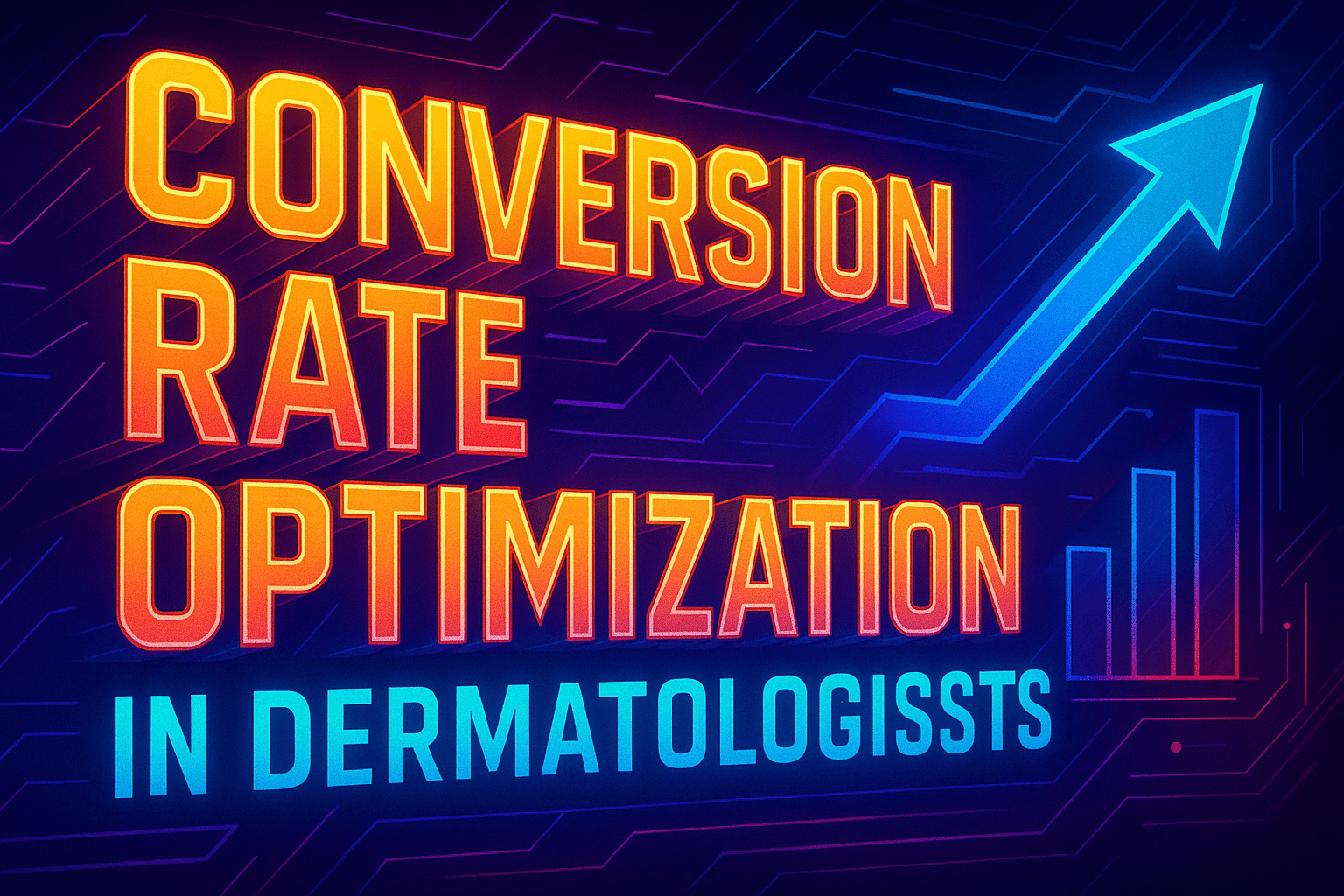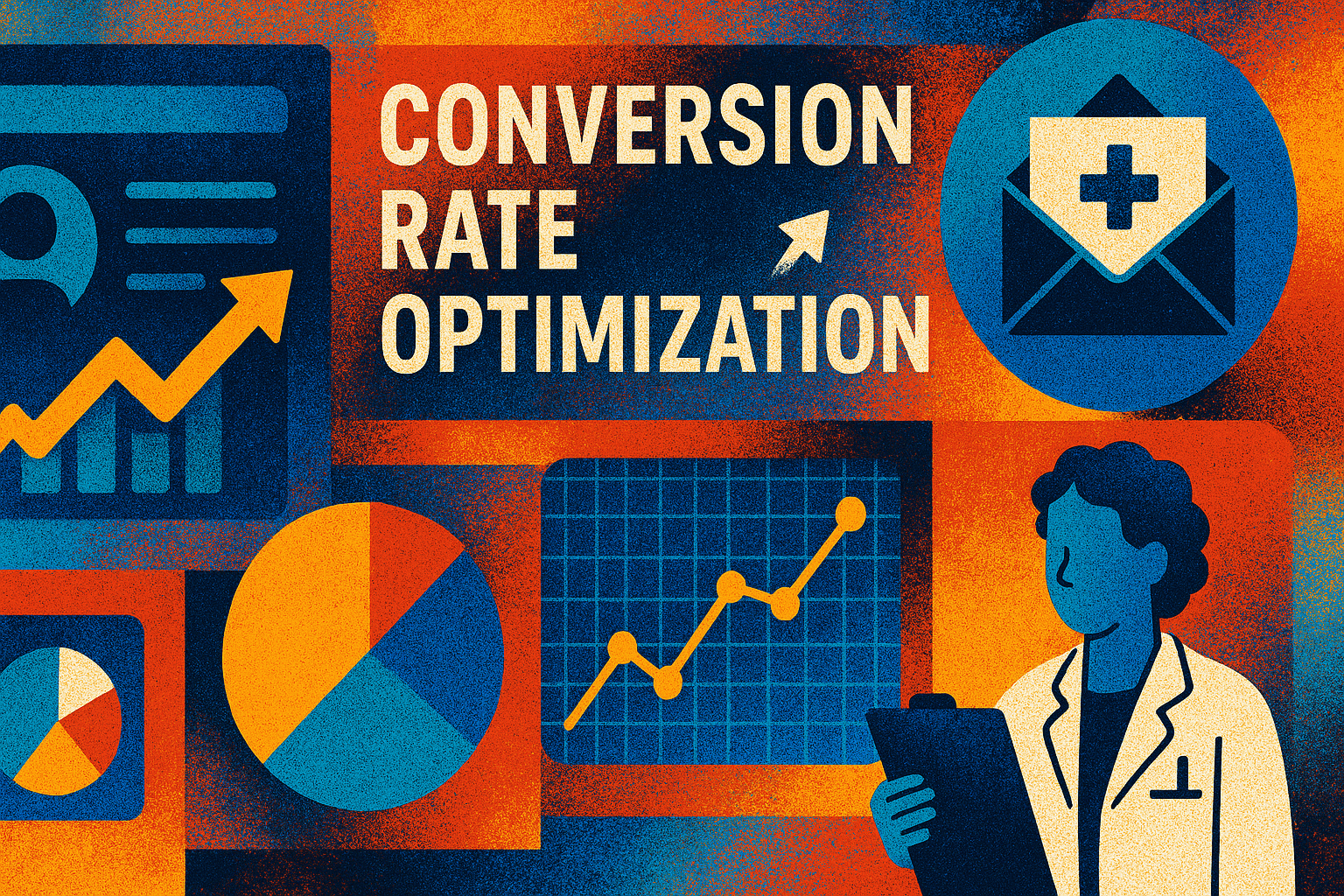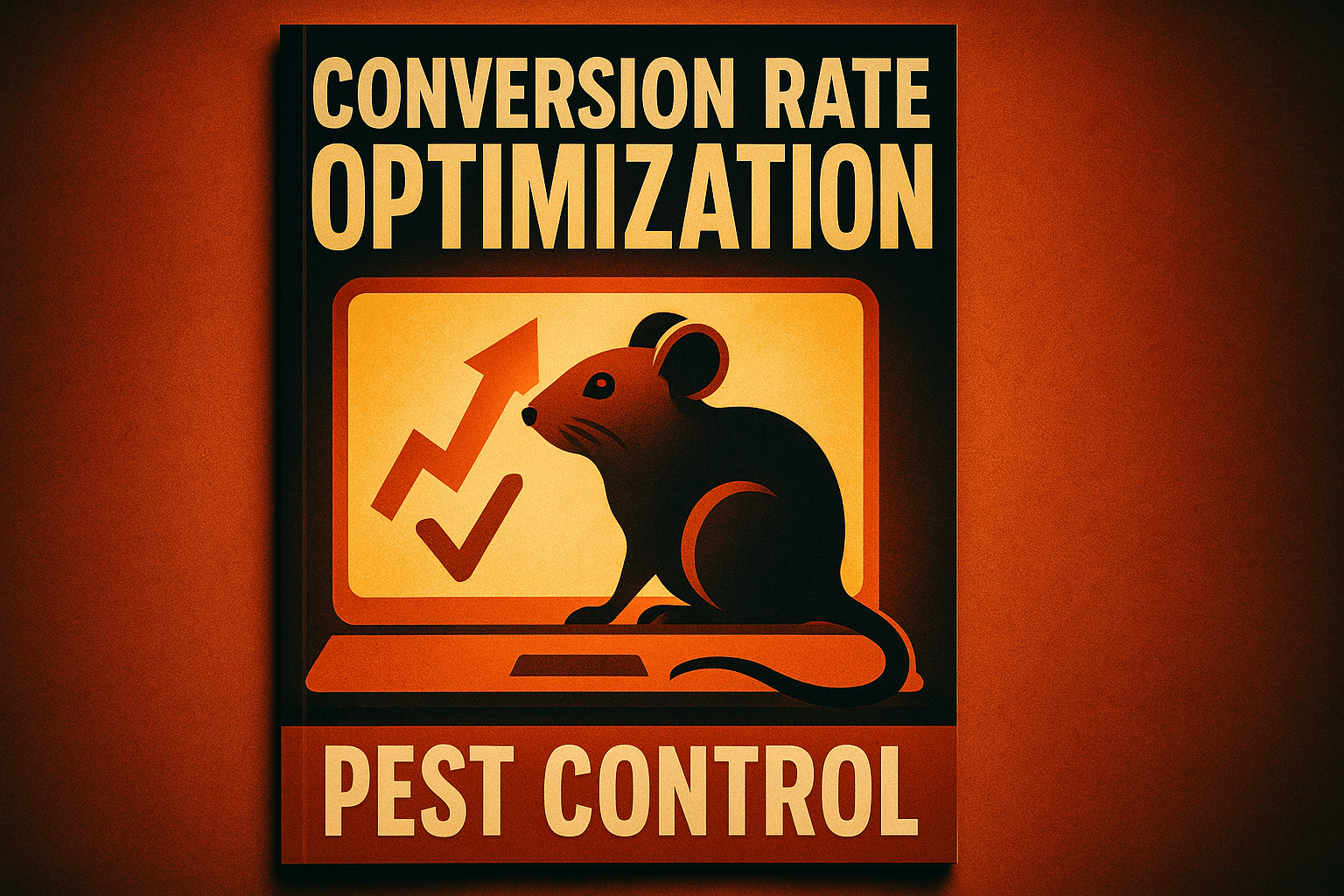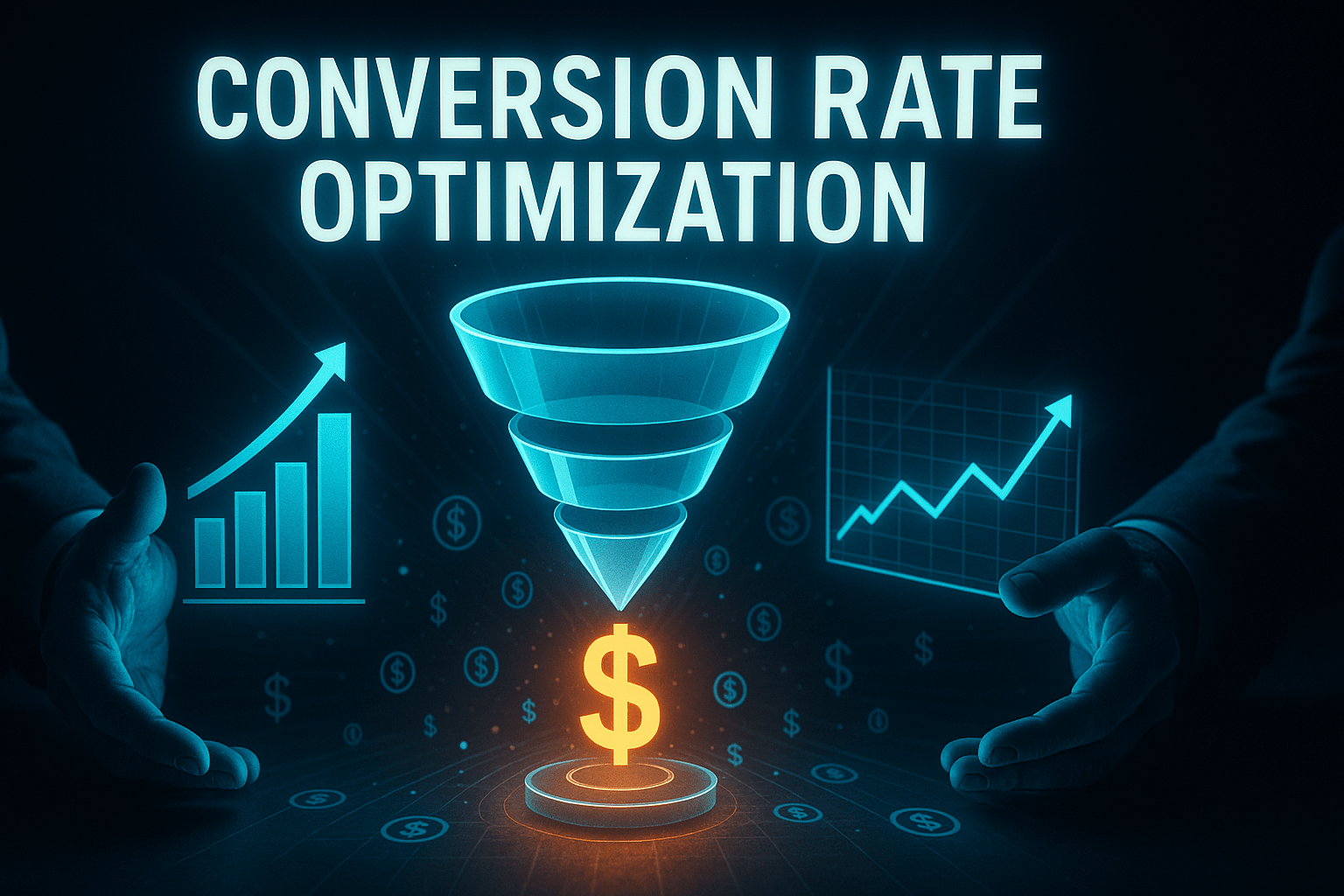Conversion Rate Optimization for Dermatologists: Turn More Visitors Into Patients
by Design Delulu Editorial · October 27, 2025

Smart, fast, and measurable. Here's how conversion rate optimization helps Dermatologists win.
Every dermatology practice faces the same frustrating challenge: thousands of website visitors who never book an appointment. Your Google Ads are working, your SEO is driving traffic, but somewhere between the homepage and the 'Book Now' button, potential patients disappear. This isn't just a marketing problem—it's a revenue leak that costs practices tens of thousands in lost appointments every year.
Conversion rate optimization (CRO) for dermatologists solves this by transforming how your website converts browsers into booked patients. Instead of spending more on advertising to get more traffic, CRO maximizes the value of visitors you already have. A dermatology practice converting at 2% that improves to 4% effectively doubles their patient acquisition without spending another dollar on ads. That's the power of systematic, data-driven optimization built specifically for medical practices where trust, credibility, and patient experience determine whether someone clicks 'Schedule Consultation' or closes the tab.

Why Dermatology Practices Need Specialized Conversion Optimization
Dermatology sits at a unique intersection in healthcare marketing. Unlike emergency medicine where need drives immediate action, dermatology patients research extensively before booking. They're comparing providers, reading reviews, analyzing before-and-after photos, and evaluating whether your practice understands their specific concern—whether that's stubborn acne, cosmetic treatments, or medical dermatology for chronic conditions.
The patient journey in dermatology is complex and multi-touchpoint. Someone searching for 'Botox near me' has different intent and skepticism levels than someone seeking treatment for psoriasis. Your website needs to address both audiences while building sufficient trust to overcome the natural hesitation around medical procedures. This means conversion optimization isn't just about better buttons and faster forms—it's about strategically removing friction at every stage of the patient decision journey.
Standard ecommerce CRO tactics fail in healthcare because the stakes are higher. Patients aren't buying products; they're trusting you with their skin, their appearance, and their health. Your conversion strategy must account for HIPAA compliance, medical credibility signals, transparent pricing (where possible), insurance questions, and the emotional weight of cosmetic versus medical dermatology decisions. Generic CRO approaches ignore these healthcare-specific conversion barriers, which is exactly why dermatology practices need specialized optimization frameworks.
The Financial Impact of Poor Conversion Rates
Let's quantify what inadequate conversion optimization actually costs a dermatology practice. Assume your practice spends $5,000 monthly on digital marketing driving 2,000 website visitors. At a 2% conversion rate, that's 40 appointment requests per month. If your average patient lifetime value is $1,200, you're generating $48,000 in patient value monthly.
Now run the same scenario at 4% conversion: same traffic, same ad spend, but 80 appointments generating $96,000 in patient value. That's an additional $48,000 monthly—$576,000 annually—without increasing your marketing budget by a single dollar. This is why conversion rate optimization delivers the highest ROI of any marketing investment. You're not buying more traffic; you're maximizing what you already have.
But most dermatology practices operate with conversion rates between 1-3%, leaving massive revenue on the table. Common culprits include:
- Unclear value propositions that fail to differentiate your practice from competitors
- Poor mobile experiences when 70% of healthcare searches happen on smartphones
- Confusing navigation that makes finding services or booking appointments unnecessarily difficult
- Missing trust signals like credentials, certifications, patient testimonials, and clear treatment explanations
- Slow page speeds that cause 53% of mobile users to abandon sites loading longer than 3 seconds
- Generic content that doesn't address specific patient concerns or treatment anxieties
Each of these issues is fixable through systematic conversion rate optimization. The question isn't whether CRO works—it's how quickly you can implement it.
Core Components of Dermatology Conversion Optimization
Effective CRO for dermatology practices rests on four interconnected pillars that work together to systematically improve patient acquisition rates.
1. Data-Driven Testing and Experimentation
A/B and multivariate testing form the foundation of conversion optimization. Rather than guessing what might improve conversions, testing lets you prove what actually works with your specific patient audience. This involves creating controlled experiments where one segment of visitors sees version A of a page element while another sees version B, then measuring which performs better against clear metrics like appointment requests, form submissions, or phone calls.
For dermatology practices, high-impact test candidates include:
- Homepage hero sections: Testing different headlines, subheadlines, and calls-to-action
- Service page layouts: Comparing treatment descriptions with and without pricing transparency
- Booking form fields: Testing shorter forms versus comprehensive intake questionnaires
- Before/after photo galleries: Different presentation formats and accompanying testimonials
- Trust badge placement: Testing locations and types of credibility indicators
- Mobile booking flow: Streamlined versus detailed appointment scheduling paths
The key is building an experiment backlog prioritized by potential impact and implementation effort. Start with high-traffic pages where small improvements generate outsized results, then expand to lower-traffic but high-value conversion points like consultation request pages.
2. Behavioral Analytics and User Insights
Numbers tell you what's happening; behavioral data tells you why. Heatmaps, session recordings, and user flow analysis reveal where visitors get stuck, confused, or frustrated. You might discover patients abandoning your booking form at the insurance question, or spending 30 seconds hovering over treatment pricing without clicking through, or rapidly scrolling past your credentials section searching for something else entirely.
This qualitative data complements quantitative analytics by exposing friction points that pure numbers miss. Common insights from dermatology practice analysis include:
- Visitors clicking non-clickable elements expecting them to be buttons
- Mobile users struggling with tiny form fields or non-responsive layouts
- Patients leaving treatment pages to Google unfamiliar medical terms
- Desktop users never scrolling far enough to see key conversion elements
- Confusion around whether services require referrals or accept specific insurance
Heuristic analysis pairs with these tools by applying conversion optimization best practices specific to healthcare. This includes evaluating clarity of messaging, strength of value propositions, effectiveness of trust signals, logical information hierarchy, and elimination of unnecessary friction throughout the patient journey.
3. Messaging and Offer Optimization
The words on your website matter as much as the design. Message optimization ensures every headline, subheadline, body copy, and call-to-action aligns with patient intent and addresses specific conversion barriers. Generic healthcare copy like 'Quality dermatology care' gets ignored; specific, benefit-focused messaging like 'Clear acne in 12 weeks with personalized treatment plans—no referral needed' converts.
Effective dermatology messaging addresses three critical questions every potential patient asks:
- Do you treat my specific concern? Explicitly name conditions, treatments, and patient types
- Why should I choose your practice? Communicate unique differentiators beyond 'experienced and caring'
- What happens next? Remove uncertainty about booking, insurance, costs, and first-visit expectations
Offer optimization goes beyond messaging to test different patient acquisition incentives. This might include free consultations for specific treatments, new patient specials, financing options for cosmetic procedures, or bundled service packages. The goal is finding offers that reduce booking hesitation without devaluing your services or attracting price-shoppers unlikely to become long-term patients.
4. Template Systems and Scalable Wins
One-off optimizations deliver one-off results. Template systems multiply your CRO efforts by baking successful patterns into reusable frameworks. When testing reveals that service pages with specific structures—treatment overview, candidate criteria, what to expect, before/after examples, FAQ section, clear CTA—convert 35% better, that structure becomes your template for all service pages.
This systematic approach means every optimization compounds. As you discover high-performing elements through testing, they get incorporated into templates used across your site. Scalable wins might include:
- Standardized trust signal layouts showing credentials, years of experience, and patient counts
- Proven CTA button copy and design that gets rolled into all conversion points
- Optimized mobile booking flows applied site-wide
- High-converting landing page structures used for paid ad campaigns
- Testimonial formats and placements that maximize credibility impact
Templates don't mean boring or identical pages—they mean proven conversion frameworks customized with specific content. This lets practices scale optimization efforts efficiently without starting from scratch for every new page or campaign.

The Four-Phase CRO Implementation Process
Successful conversion optimization follows a structured methodology that ensures changes are strategic, measurable, and tied directly to revenue outcomes.
Phase 1: Discovery and Goal Alignment
Every engagement begins by establishing what success looks like. This means clarifying business objectives beyond 'more conversions'—are you prioritizing high-value cosmetic consultations over quick medical appointments? Focusing on specific treatments with better margins? Building long-term patient relationships versus one-time procedures?
Discovery includes:
- Analytics audit: Reviewing current traffic sources, conversion funnels, and performance baselines
- Stakeholder interviews: Understanding practice priorities, constraints, and past marketing efforts
- Competitive analysis: Evaluating how nearby practices position and convert
- Technical assessment: Identifying platform limitations, tracking gaps, or implementation barriers
- Success metrics definition: Establishing KPIs tied to revenue, not vanity metrics
This phase typically takes 1-2 weeks and creates alignment on scope, timeline, and expected outcomes. Clear success metrics are critical—CRO isn't about increasing page views or time-on-site; it's about measurable improvements in appointment bookings, consultation requests, and ultimately patient acquisition cost and lifetime value.
Phase 2: Strategic Blueprint Development
With goals established, the blueprint phase designs the optimization strategy, prioritizes initiatives, and creates the measurement architecture needed to validate results. This involves mapping the complete patient journey from first touch to booked appointment, identifying friction points at each stage, and hypothesizing specific improvements likely to move conversion metrics.
The strategic blueprint includes:
- Conversion funnel analysis: Mapping drop-off points and optimization opportunities
- Prioritized experiment backlog: Ranked test ideas based on potential impact and effort
- Measurement plan: Defining what gets tracked, how, and success thresholds for each test
- Design and messaging frameworks: Creating hypotheses for improved layouts, copy, and CTAs
- Technical requirements: Outlining implementation needs, testing tools, and integration specifications
Prioritization is crucial because not all optimizations deliver equal value. A 20% improvement on a page getting 100 monthly visitors adds minimal revenue; that same improvement on a high-traffic service page transforms results. The blueprint ensures you're focusing on highest-impact opportunities first.
Phase 3: Build, Test, and Launch
Implementation translates strategy into live experiments. This phase involves creating test variations, ensuring proper tracking implementation, conducting QA across devices and browsers, and launching experiments to a controlled percentage of traffic. For dermatology practices, this often means balancing aggressive testing with maintaining brand consistency and medical credibility.
Build and launch activities include:
- Designing and developing test variations (new layouts, copy, CTAs, forms)
- Implementing tracking pixels and event listeners for conversion measurement
- QA testing across mobile devices, tablets, desktop, and multiple browsers
- Validating HIPAA compliance for any forms or data collection changes
- Launching experiments with appropriate traffic allocation and control groups
- Monitoring initial data to ensure tracking accuracy and catch any technical issues
Most tests need at least 2-4 weeks to reach statistical significance, depending on traffic volume and conversion rate differences. During this period, continuous monitoring ensures tests are running correctly and delivering clean data. Practices with lower traffic may need longer test durations or broader changes to detect meaningful differences.
Phase 4: Optimization and Iteration
The optimization phase is where consistent improvement happens. As tests conclude, winning variations get implemented permanently, learnings inform future tests, and the experiment backlog gets refreshed based on new data. This isn't a one-time project—it's an ongoing cycle of testing, learning, and improving.
Continuous optimization involves:
- Results analysis: Evaluating test outcomes, statistical significance, and business impact
- Implementation of winners: Rolling successful variations into production templates
- Insight documentation: Capturing learnings about what works (and doesn't) for your audience
- Backlog refinement: Updating priorities based on new data and evolving business goals
- Reporting and stakeholder updates: Communicating results, ROI, and strategic recommendations
Regular optimization reviews—typically weekly or bi-weekly—keep momentum going and ensure the program stays aligned with practice priorities. Quarterly strategy resets allow for bigger-picture evaluation of what's working, where opportunities remain, and how CRO efforts contribute to overall practice growth.
Critical Success Factors for Dermatology CRO
Converting website visitors into patients requires more than technical optimization. These strategic principles separate high-performing practices from those that struggle despite having similar traffic and services.
Map Search Intent to Patient Journey Stages
Not all dermatology searches signal the same readiness to book. Someone searching 'what causes acne' is in early-stage research; someone searching 'dermatologist accepting new patients near me' is ready to schedule. Your conversion strategy must address visitors at different journey stages with appropriately matched content and CTAs.
High-intent searches (treatment names, 'near me' queries, procedure-specific terms) should land on service pages optimized for immediate conversion with prominent booking options. Informational searches should land on educational content that builds trust, demonstrates expertise, and guides visitors toward treatment pages when they're ready. Mismatching intent to landing page content destroys conversion rates—someone researching rosacea triggers doesn't want an immediate 'Book Now' hard sell.
Lead with Social Proof and Outcomes
Healthcare decisions require high trust, and social proof is the fastest way to build credibility with new visitors. This includes patient testimonials, before/after photos, review ratings, years in practice, number of patients treated, and any notable credentials or specializations. These trust signals should appear early—above the fold on key pages—not buried at the bottom where most visitors never scroll.
Outcomes matter more than process. Patients care less about your specific laser technology and more about 'Clear skin in 8 weeks with minimal downtime.' Lead with benefits and results, support with credibility indicators, then provide technical details for those who want them. Front-load trust and value; make technical specifications available but not prominent.
Establish Single Source of Truth Dashboards
You can't optimize what you don't measure accurately. A single source of truth dashboard consolidates all key conversion metrics—website traffic, form submissions, phone calls, appointment bookings, patient acquisition cost, and revenue per patient—into one place that stakeholders check regularly.
This eliminates the confusion of conflicting data sources and creates accountability around metrics that matter. Your dashboard should answer: Are more visitors converting? Is cost per acquisition improving? Are we booking higher-value appointments? Which traffic sources and pages drive the best patients? Weekly reviews of this dashboard keep the team focused on moving the right numbers.
Implement Small, Test Fast, Compound Wins
The biggest CRO mistake is waiting months to launch perfect, comprehensive redesigns. Velocity matters more than perfection. Ship smaller changes quickly, measure results, keep what works, and discard what doesn't. A dozen small improvements that each lift conversions 5-10% compound into transformative results, while a single big bet might fail spectacularly.
This 'test fast' philosophy means having bias toward action. Instead of spending six weeks debating the perfect homepage hero image, test three options in two weeks and let data decide. The faster you test, the faster you learn, and the faster your conversion rate improves. Practices that ship weekly optimizations outperform those doing quarterly redesigns every single time.

Common Conversion Killers in Dermatology Websites
Even well-designed dermatology websites often sabotage their own conversion rates through these preventable mistakes:
Unclear or Generic Value Propositions
'Comprehensive dermatology care' and 'experienced, caring providers' describe literally every practice. Generic positioning fails to give visitors any reason to choose you over competitors. Your value proposition must communicate specific, differentiated benefits—'Same-week appointments for acne emergencies,' 'Cosmetic dermatology with 20+ years specializing in skin of color,' or 'Medical and cosmetic dermatology in one practice—no referrals needed.'
Mobile-Hostile Experiences
With 70%+ of healthcare searches happening on smartphones, mobile optimization isn't optional—it's primary. Yet many dermatology sites have tiny text, non-responsive layouts, forms that are nightmares to complete on phones, or click targets too small for thumbs. If mobile visitors can't easily find services, read content, and book appointments, your conversion rate will stay stubbornly low no matter what else you optimize.
Booking Friction and Complexity
Every field in your booking form, every step in your scheduling process, and every moment of uncertainty reduces conversion rates. Ask yourself: can someone book an appointment in under 60 seconds from any page? If not, you're losing patients. Streamline forms to essential fields only, offer one-click phone calling, provide instant calendar availability, and eliminate unnecessary intake steps before first appointment confirmation.
Missing or Weak Trust Signals
New visitors don't know you, haven't heard of you, and are naturally skeptical. Without strong, visible trust indicators, they'll keep researching. This means prominently displaying credentials, years of experience, patient review ratings, before/after galleries, professional associations, awards, media mentions—any evidence that you're competent, reputable, and trustworthy. These shouldn't be afterthoughts buried in footers; they should be strategic elements in your conversion architecture.
Slow Page Load Speeds
Website speed directly impacts conversion rates—a one-second delay reduces conversions by 7%. Dermatology sites often load slowly due to unoptimized images (especially before/after galleries), excessive scripts, poorly coded themes, or inadequate hosting. Speed optimization isn't just technical housekeeping; it's a direct conversion lever. Prioritize fast load times, especially on mobile, and watch booking rates improve.
Measuring ROI: Key Metrics for Dermatology CRO
Effective conversion optimization requires tracking the right metrics—those that tie directly to revenue and practice growth, not vanity numbers that look impressive but don't drive business results.
Primary Revenue Metrics
- Conversion Rate: Percentage of visitors completing desired actions (form submissions, calls, bookings)
- Cost Per Acquisition (CPA): Total marketing spend divided by new patients acquired
- Patient Lifetime Value (LTV): Average revenue generated per patient over their relationship with your practice
- Revenue Per Visitor: Total patient revenue divided by website traffic (the ultimate CRO metric)
- Booking Rate: Percentage of consultation requests that convert to scheduled appointments
Supporting Channel Metrics
- Traffic by Source: Volume and quality of visitors from organic search, paid ads, social, referral
- Bounce Rate by Page: Percentage of single-page visits indicating content-audience mismatch
- Form Abandonment Rate: Where users drop off in booking or contact forms
- Page Speed: Load times for key conversion pages across devices
- Click-Through Rate (CTR): Percentage clicking primary CTAs and key navigation elements
Qualitative Insight Metrics
- Session Recordings: Observing real user behavior, confusion points, and friction
- Heatmap Analysis: Understanding where attention goes and what gets ignored
- User Surveys: Direct feedback on why visitors don't book or what information they need
- Patient Interviews: Post-booking discussions about what influenced their decision
The most successful dermatology practices align their entire team around a core set of metrics reviewed weekly. This creates organizational clarity about what success looks like and ensures everyone understands how their work contributes to conversion improvement and revenue growth.
Advanced CRO Strategies for Growing Practices
Once foundational optimization is in place, these advanced strategies take conversion performance to the next level.
Segmented Messaging by Treatment Type
Medical dermatology patients have different motivations than cosmetic patients. Someone seeking psoriasis treatment cares about insurance acceptance, treatment efficacy, and medical expertise. Someone seeking Botox cares about natural-looking results, provider skill, and whether results are worth the investment. Generic messaging tries to appeal to everyone and converts no one effectively.
Segment your site architecture, messaging, and CTAs by patient type. Create separate landing experiences for medical versus cosmetic services, with tailored trust signals, benefit statements, and conversion paths. This targeted approach consistently outperforms one-size-fits-all strategies because it addresses specific needs, concerns, and decision criteria for each patient segment.
Remarketing Optimization
Most website visitors don't book on first visit—they research, compare, think about it, and return later. Remarketing keeps your practice top-of-mind during this decision window. But generic 'Come back!' ads waste budget. Effective remarketing is personalized: visitors to acne treatment pages see acne-specific messaging and offers; visitors to cosmetic pages see cosmetic-focused remarketing.
Layer in sequential remarketing that evolves messaging based on engagement. First touchpoint: reinforce value proposition. Second: address common objections. Third: introduce limited-time offers or incentives. This strategic remarketing converts browsers into bookers more efficiently than spray-and-pray advertising.
Conversion-Optimized Content Marketing
Most dermatology content marketing focuses on education and awareness, treating 'conversions' as an afterthought. Conversion-focused content does both simultaneously—answering patient questions while strategically guiding readers toward booking. This means educational blog posts with embedded CTAs at optimal moments, condition guides that transition naturally to treatment options, and FAQ content that removes booking objections.
The goal isn't to make every piece a hard sell; it's to ensure content serves both education and conversion goals. Someone reading 'How to treat hormonal acne' is showing treatment interest—guide them to your acne treatment page with contextual, helpful CTAs that feel like natural next steps, not interruptions.
Intelligent Chat Implementation
Live chat and chatbots can dramatically improve conversion rates by answering questions, reducing uncertainty, and facilitating immediate booking. But poorly implemented chat annoys users and hurts credibility. Effective chat for dermatology practices is strategic:
- Appears on high-intent pages (service pages, booking pages) not site-wide
- Uses timing triggers (appears after 30 seconds or if user shows exit intent)
- Offers specific help related to the current page, not generic 'Can I help you?'
- Includes quick-access scheduling options for visitors ready to book
- Routes to human staff during business hours, intelligent bot after-hours
When done right, chat reduces booking friction, answers objections in real-time, and captures leads that would otherwise leave. When done wrong, it's an annoying popup that gets immediately closed.
Frequently Asked Questions
Let’s level up your Dermatologists business
Need services that actually move the needle for Dermatologists? See our approach, pricing, and timelines—then book a quick call.
Additional Resources
- Schedule Your CRO Strategy Session
Book a 30-minute consultation to discuss your practice's conversion challenges. We'll review your current metrics, identify quick-win opportunities, and outline a customized optimization roadmap with projected ROI and timelines.
- View Our Dermatology CRO Portfolio
See real results from our conversion optimization work with dermatology practices—detailed case studies showing before/after metrics, testing strategies, and revenue impact across medical and cosmetic dermatology clients.
- Access Free CRO Tools & Resources
Download our free conversion rate calculator, landing page audit checklist, and A/B testing prioritization framework—practical tools designed specifically for dermatology practices looking to improve patient acquisition and booking rates.
Related Reading

Maximize pest control leads with proven conversion rate optimization. Get A/B testing, landing page optimization, and data-driven strategies that increase bookings.

Transform your financial advisory practice with data-driven conversion rate optimization. Increase qualified leads by 40-150% through strategic testing and optimization.
